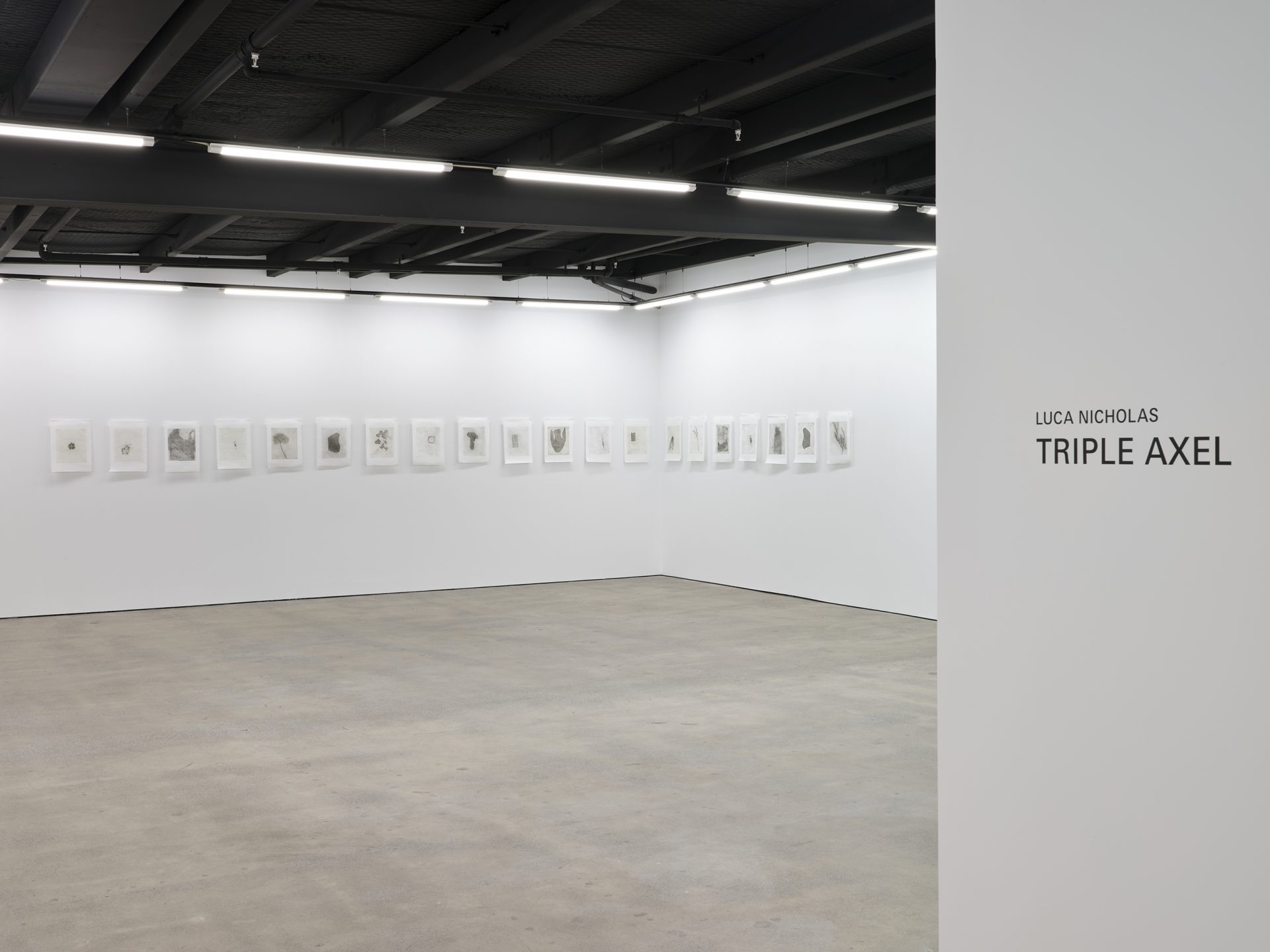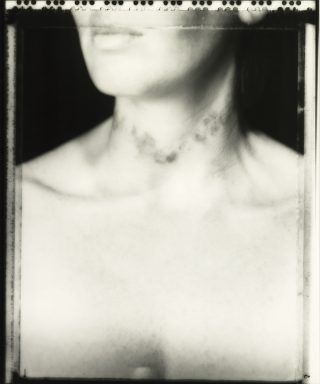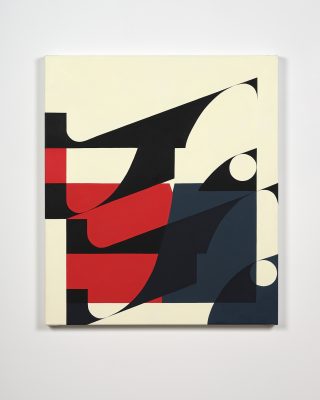Triple Axel is Luca Nicholas’s first solo exhibition and the culmination of his study at Auckland University of Technology, where he recently completed his Master of Visual Arts degree. The print-based works on show are the product of experimentation with diverse processes and concepts, as Nicholas has attempted to develop a mode of making that explores queer experiences with ‘pathos, humour, and care’. The title of the show is wry, reflecting his current state of mind: a mixture of relief and apprehension. In figure skating, a ‘triple Axel’ is a kind of jump that is notoriously difficult to execute (it is named for the Norwegian skater Axel Paulsen, who originated the single rotation version of the manoeuvre). To pull off a triple Axel indicates serious skill. Yet it is no guarantee of future success. The next attempt might result in failure. To get a degree and then quickly present a solo show is an achievement, no question. But what comes next?
Among the earliest works in Triple Axel is an etching with monoprint colour titled Tonya Harding, Liza Minnelli Tries to Turn Off a Lamp, and Muscle Bear Combo 03 (2018). The image depicts a bedroom. On the back wall, there is a chine collé ‘poster’ showing Harding, who became the first American woman to land a triple Axel in 1991. In recent years, she has achieved renewed fame, even cult status, thanks largely to two 2014 documentaries and the 2017 biopic I, Tonya. The films emphasise not only her prowess on the ice, but also her complicated home life, and her role in a 1994 attack on her rival, Nancy Kerrigan, carried out by Harding’s ex-husband. Nicholas’s work shows the skater pre-scandal, at the competition that saw her perform the triple Axel. She is at the height of her powers, the winner of the day. One can only imagine what might have happened had she gone on to make different decisions. Sometimes, it seems, it is wiser to quit while you’re ahead.

Luca Nicholas, Tonya Harding, Liza Minnelli Tries to Turn Off a Lamp, and Muscle Bear Combo 03, 2018. Photograph by Samuel Hartnett, courtesy of the artist.
A second work, but baby, what can you do? (2018), further nods towards life choices and career trajectories. The image shows Nicholas’s studio at AUT, an ostensibly comforting environment, with its orderly workspace, coffee plunger, and bank of windows bringing that good light. A wall at left is taken up with a still from a 1969 musical comedy, Sweet Charity, directed by Bob Fosse. In the scene represented, two ‘taxi dancers’ (or dancers for hire) sing about their intention to leave their dance-hall lives behind and to move up in the world. A third, Charity, played by Shirley MacLaine, chimes in that she’s going to get out too, only to be asked, ‘But baby, what can you do?’ Nicholas has superimposed a portion of the lyrics over the still, after the fashion of a meme. Into his studio-haven, he inserts a note of uncertainty, seeming to question both his abilities and their relationship to his future.
The Sweet Charity reference is shaded with other meanings. Nicholas notes that the dancers’ ambitions are limited. They aspire to work in clothing stores (as he himself has done for some time), or as receptionists. While some things have clearly changed since the 1960s, gender—in all its complexity—can still curb opportunities. The reference also alludes to the enduring problem of sexual harassment, since the characters’ desire to leave the dance hall is motivated in part by groping clients. Equally, however, there is levity in Nicholas’s work. Campy in style, it celebrates a range of queer phenomena. While Sweet Charity is not a gay staple as such, Fosse musicals in general certainly are. The bench at right in the image includes a copy of the queer-flavoured graphic novel Ghost World and a book by well-known gay artist Robert Mapplethorpe. Pasted over a picture of Diana Ross is one showing the hyper-masculine cartoon character He-Man, extracted from a parodic video featuring a spangled rainbow backdrop.
Similar references are also present in Tonya Harding, Liza Minnelli Tries to Turn Off a Lamp, and Muscle Bear Combo 03, as the title of the work suggests. Lying open on a bed in the foreground is a laptop. A browser window displays a Saturday Night Live skit, in which queer icon Minnelli (played by Kristen Wiig) struggles to turn off a lamp due to an excess of shimmy-like body ticks. Another window shows the kind of man known in gay parlance as a ‘muscle bear’, due to robust physique and obvious body hair. The implication is that the work is a snapshot of some private downtime streaming. We the viewers occupy the position of the laptop owner, as if we are seated on the bed. The scene is offered up to us in all its specificity and intimacy. Whether we are to feel welcome, nosey, or outright intrusive remains unclear.

Luca Nicholas, Krull and bad vegan pizza, 2018. Photograph by Samuel Hartnett, courtesy of the artist.
A still greater sense of ambiguity marks a third etching and monoprint hybrid, Krull and bad vegan pizza (2018). The ‘Krull’ of the title nods to a cult science fantasy film of the same name from 1983. The image again shows a room—ostensibly a lounge, since the top of a couch runs along the bottom edge. Red predominates (a plant at left is picked out in muted green), connecting the work to well-known near-monochromes like Henri Matisse’s Red Studio (1911). The tone is gorgeous and intriguing, if not a little unsettling. Its origins are not apparent. Perhaps the room is bathed in the glow of a television. Perhaps someone has thrown a scarlet scarf over a lamp to set the mood. Perhaps the colour is merely the result of dramatic decorating decisions. The underlying narrative is equally unknown. A movie night with friends? A date night? It’s anyone’s guess.
A fourth etching, you gotta ride it, baby (2019), shows a bed framed by a pair of hanging lamps, backed by what appears to be a freestanding wall, and attended by quirky vessels. The scene is profuse in credibly distinctive detail but also abstracted. The background slips between interior and exterior, being desert buff at the bottom and sky blue up top. A form in a dark red the colour of dried blood rises up on the left like a craggy rock-form, or even a hand grasping the partition. The bedding is slightly rumpled, suggesting recent use or a hurried tidy. The work calls to my mind earlier representational etchings by Nicholas, so-called Grindr studies replicating images of men from the eponymous hookup app. Some of these works focussed on bodies, buttocks in the air, torsos flexed. Others (with a certain David Hockney air) emphasised the subjects’ rooms, carefully tidied or left as they happened to be—different choices suggesting different levels of self-scrutiny or candour.
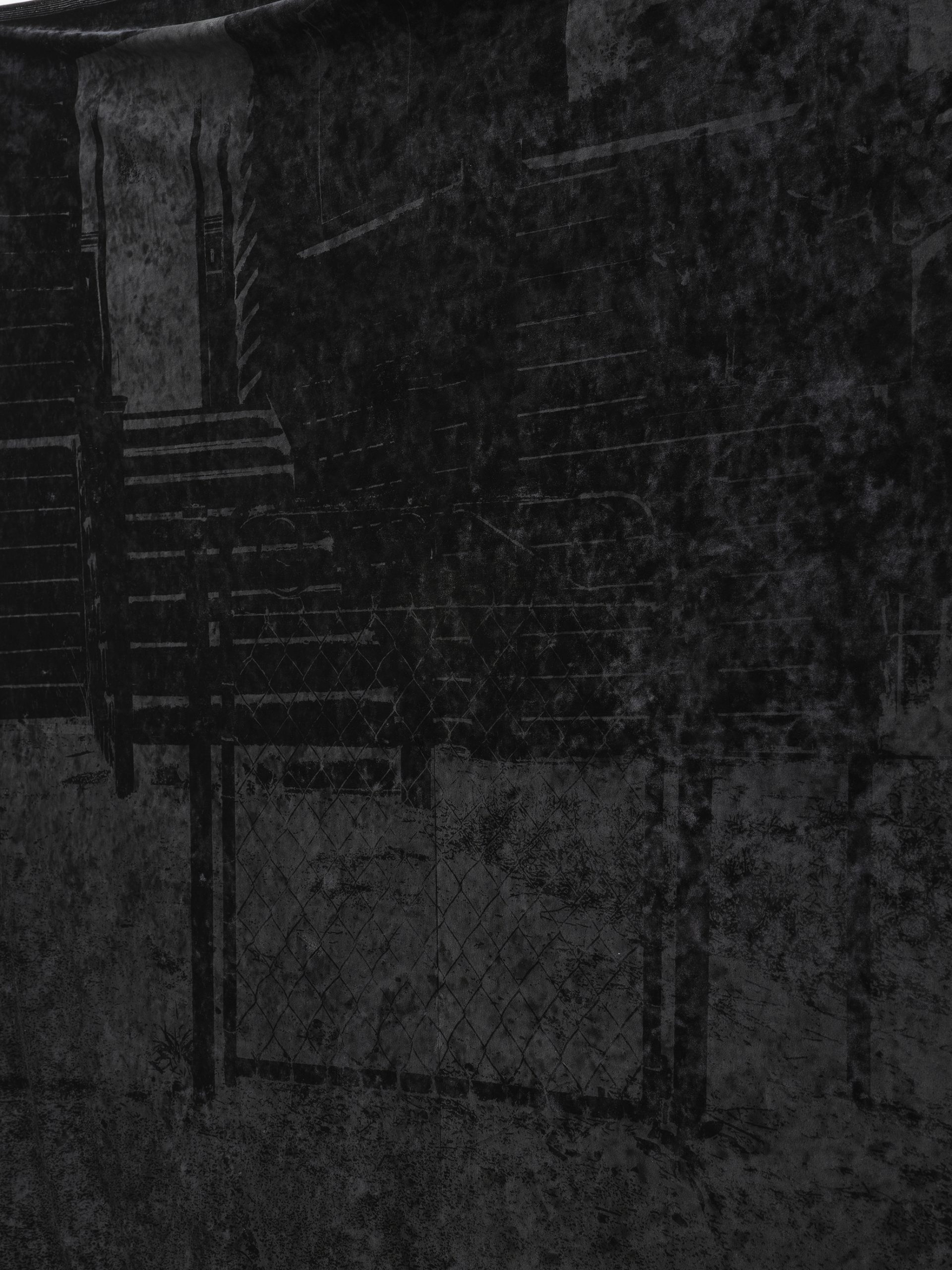
Luca Nicholas, threshold (detail), 2020. Photograph by Samuel Hartnett, courtesy of the artist.
Unlike the Grindr studies, the ‘room-based’ works in Triple Axel do not include any immediate protagonists. The only clues as to what might be going on come from the spaces and items that festoon them. Nicholas has progressively leaned into such traces as indices of individuals and their experiences. Of late, he has also shown an increased interest in outdoor environments. Two works that exemplify the shift are hedges (2019) and threshold (2020), which respectively incorporate photographs of a hedge and a gate in front of a house from the early 20th century. The pieces are both large-scale screenprints. The ink has locked the velvet tuft in place, creating images visible only from certain angles. Front on, each work appears solidly monochromatic. A sidelong glance reveals the picture, ghostly, as if seen through a gauze curtain or the decaled window of a bus.
A large number of etchings on diaphanous mulberry paper, collectively titled in bloom (2019), depict detritus that one might find littering the footpath alongside a gate or hedge: bits of food, pill packets, shrubs, sticking plasters. In order to create the images, Nicholas has rolled the objects themselves through the press, causing them to smash into the soft ground preparation on the plates. He has been employing a similar process for some time. Initially, however, he used it to capture texture alone. For instance, pieces of cloth were used to give the impression of fabric in pictorial elements like the couch in Krull and bad vegan pizza. In the in bloometchings, by contrast, each object becomes a complete image. The resulting pieces are reminiscent of botanical artworks, such as the engravings of plants collected during the 1768–71 voyage of the Endeavour under Captain James Cook, and later pictures of Aotearoa flora by Sarah Featon and Georgina Hetley.

Luca Nicholas, Triple Axel (installation view), Visions, Tāmaki Makaurau, 2020. Photograph by Samuel Hartnett, courtesy of the artist.
Further analogues for the etchings are the botanical cyanotypes (that is, blue-tinted photograms) of Anna Atkins. Like them, the in bloom images are the product of direct contact between object and capturing medium. There is a sensuality in the process, a kind of bodily touch, which takes the place of the intimacy illustrated in previous works by Nicholas. The artist retains an interest in specificity. Where botanical artworks typically seek to exemplify groups, with one ‘specimen’ standing in for a whole class of kindred forms, the etchings are closer to portraits. They are precise likenesses of particular objects, tied to particular people, and extending from particular experiences. A pill packet is always connected to the individual who popped it, whether to ease a headache or take the edge off an anxious soul. To portray such a packet is to acknowledge a psychic as much as an environmental trace.
The final three works in Triple Axel—losing my edge ii, hyper-ballad, and new in town (all 2020)—are easily the most enigmatic. They are monumental etchings, eclipsing the in bloom works not only in scale, but also in technical difficulty. As with earlier pieces by Nicholas, they nod towards pop culture, doing so by way of their titles (hyper-ballad, for instance, is a song by Björk). All feature items fed through the press. However, they also include freehand marks: silvery scratches that recall the tumbling scrawls of Cy Twombly, or ice skate incisions on a recently polished rink; glistening smears that resemble the screenprinted gestures of Judy Millar, or sticky fluids on a newly slackened body. Real-world elements are discernible: a sleeve, a strap of plastic from about a bundle of cardboard, a ring from the neck of a milk bottle. But the whole remains inscrutable, a tangle of faint and shifting impressions.
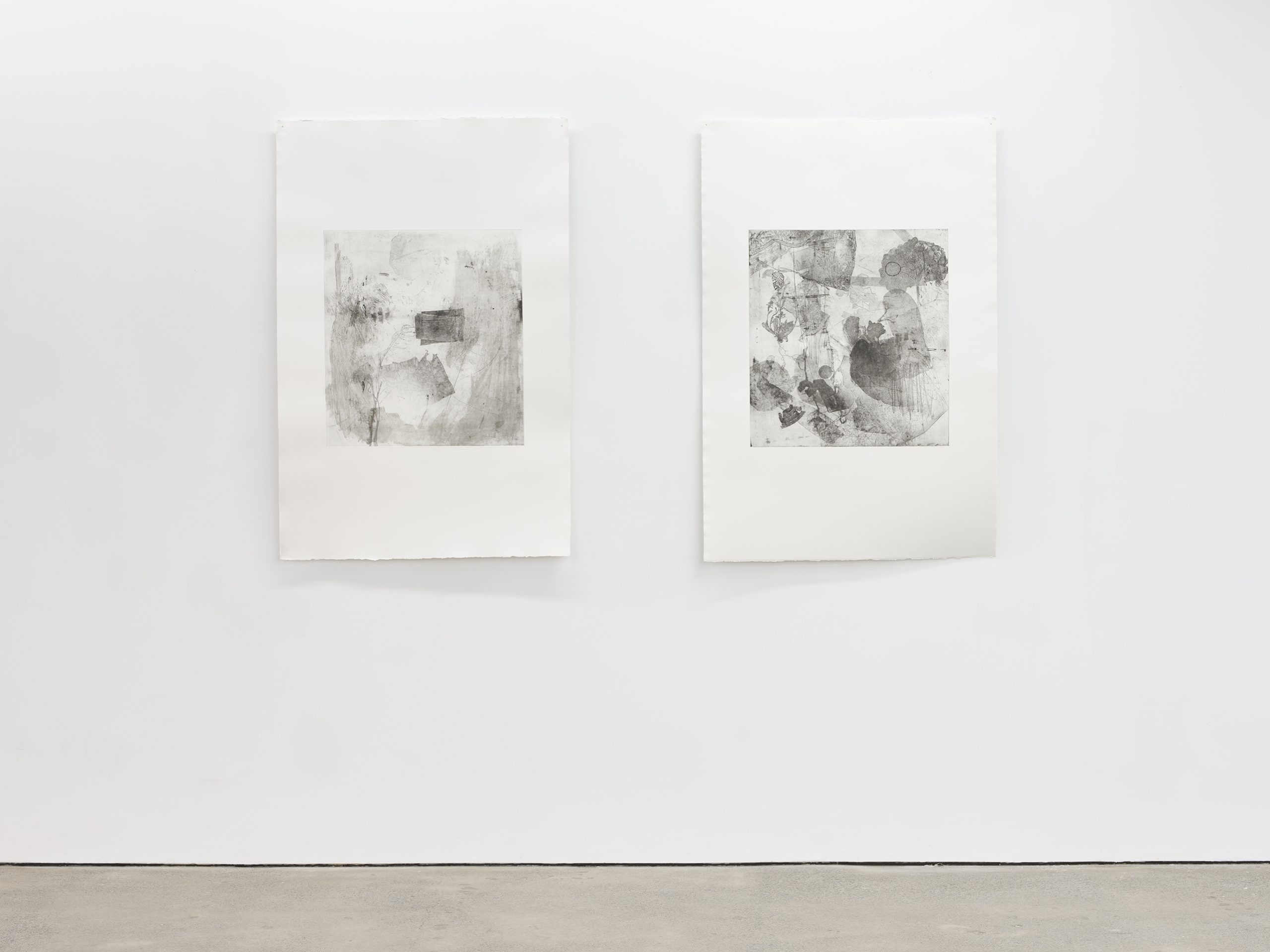
Luca Nicholas, Triple Axel (installation view), Visions, Tāmaki Makaurau, 2020. Photograph by Samuel Hartnett, courtesy of the artist.
Printed on heavy paper, the etchings are confident in their physicality, despite the absence of frames. They also possess a distinct delicacy. All the visual and emotional complexity of Nicholas’s earlier images is present, but the elements have been combed, fragmented, and left to drift. Like Triple Axel as a whole, the works are a beginning and a culmination, a first presentation to the general public of techniques that Nicholas has been perfecting in private for many months. At the same time, the show is an expression of something less sharply bounded: a practice. Today, we see Nicholas using his exceptional skills as a printmaker to aggregate myriad traces, leaning into aspects of his queerness to create works grounded in the personal. Tomorrow’s activity might be quite different. However, it will still be part of the same body, and marked by the same voice. The triple Axel landed, you seek out the next challenge. Show them what else you can do.
Triple Axel
Luca Nicholas
5 November to 5 December 2020
Visions
Tāmaki Makaurau Auckland
